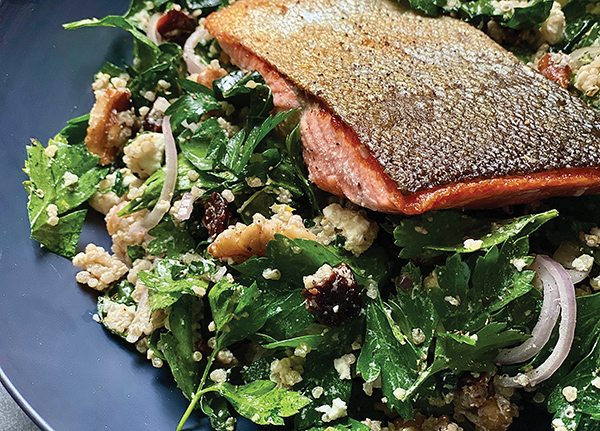HEALTHY LIVING
Support brain health: Simple ways to add to your wellness routine

(Family Features) When most people think of wellness, diet and exercise are the first things that come to mind. Brain health is another essential element of your overall wellness because it affects your quality of life in many ways.
Brain health is the foundation of your ability to live a productive and successful life by communicating and solving problems. It’s the driving force behind your daily function.
Give your brain extra support with these tips:
Stimulate Your Mind
Like any muscle, your brain needs exercise. Your workout equipment for your brain can include activities like puzzles, reading, learning an instrument, taking up a new hobby or learning a new language.
Focus on Brain-Supporting Foods
What you eat doesn’t just affect your physical health; it affects your brain health, too. One example is the Mediterranean-DASH Intervention for Neurodegenerative Delay (MIND) diet, which is the result of more than 20 years of data collected by researchers at Rush University Medical Center and Harvard School of Public Health.
It follows the Mediterranean style of eating whole foods with minimal processing and includes an emphasis on plant-based foods, including leafy greens, whole grains and heart-healthy legumes along with some fish and smaller amounts of poultry. The MIND diet aims to build on these principles and emphasizes antioxidant-rich berries, dark leafy greens and fatty fish like salmon, mackerel, herring or sardines.
A dish like Kale and Quinoa Bowl with Salmon reflects the MIND diet guidelines and is a delicious and smart way to support your brain with good nutrition.
“Fueling your brain starts with your plate,” said Melissa Halas, MA, RDN. “This tasty kale, quinoa and salmon recipe by Alton Brown has smart ingredients that match the MIND diet. Plus, the results are delicious. It’s so important to support your brain with the right nutrients.”
Sleep Well
While you catch up on your rest, your body is hard at work rejuvenating all your systems, and your brain is no exception. Getting plenty of sleep each night gives your brain time to repair itself so you wake feeling sharp and focused.
Add a Supplement to Your Daily Routine
Most people fall short of reaching recommended nutrient levels with their diets alone. Supplements can help fill the gap. An option like Neuriva Plus can help support the key indicators of brain health: reasoning (think and understand things in a logical way), focus (zoom in and filter out distractions), accuracy (react with greater speed and precision), memory (record and recall stored information), learning (retain new information) and concentration (concentrating on tasks for longer periods).*
*These statements have not been evaluated by the Food and Drug Administration. This product is not intended to diagnose, treat, cure or prevent any disease.
Available in capsules and gummies, the Neuriva brain health supplements include naturally sourced ingredients like Neurofactor™ (coffee cherry extract) and plant-sourced phosphatidylserine (PS), as well as B vitamins to support brain health.
“I recently turned 60 and over the past couple of decades, I’ve been very focused on taking care of my health from the inside out – first with my food, and now taking action to support my brain health,” said Alton Brown, award-winning chef and food geek. “Neuriva fits perfectly into my holistic regimen, which for me, is just simple life practices, like exercising, eating a balanced diet and getting a good night’s sleep.”
Manage Stress
Keeping your stress in check is good for your mental well-being, but it also affects your physical and cognitive health. Practicing yoga, meditation or listening to music are some ways to reduce stress while improving your cognitive function and performance.
Connect with Others
Personal interaction also sharpens your brain, as it encourages you to practice communication and other cognitive skills. You can protect and improve your brain health by creating and nurturing connections with friends and family.
Keep Moving
Your brain needs plenty of oxygen for good function. Physical activity burns calories and builds muscle while increasing oxygen flow and stimulating nerve cell growth.
For more ideas to support brain health and wellness, visit Neuriva.com and download the Neuriva Brain Gym app.

Kale and Quinoa Bowl with Salmon
Recipe courtesy of Alton Brown on behalf of Neuriva
Servings: 4
Kale and Quinoa Bowl:
- 1 bunch lacinato or “dinosaur” kale, stems removed and cut into ribbons (about 4 ounces, stemmed)
- 1 bunch (1 1/2 ounces) flat leaf parsley, stems removed and roughly chopped
- 2 shallots, thinly sliced
- 5 tablespoons extra-virgin olive oil, divided
- 1 lemon, zest and juice only
- 2 large garlic cloves, minced
- 1/2 cup plain, low-fat yogurt
- 4 ounces firm feta cheese, divided
- 1cup (3 1/2 ounces) walnuts, toasted and lightly crushed, divided
- 1 teaspoon kosher salt
- 2 cups cooked white quinoa
- 1/2 cup dried cherries
- freshly ground black pepper
Salmon:
- 2 skin-on salmon fillets (around 1-inch thick and 5 ounces each)
- 1/2 teaspoon kosher salt
- 2 tablespoons light olive oil
- To make kale and quinoa bowls: In large bowl, toss kale, parsley and shallots with 2 tablespoons olive oil; set aside 10 minutes.
- In bowl of food processor, puree remaining olive oil, lemon juice and zest, garlic, yogurt, 2 ounces feta, 1/3 of the walnuts and salt.
- Pour dressing over greens then fold in quinoa, remaining walnuts, cherries and remaining feta.
- Cover and refrigerate at least 1 hour before serving with several grinds of black pepper.
- To make salmon: Wrap fillets in paper towels then heat large cast-iron skillet over medium-high heat 5 minutes.
- When skillet is hot, season fillets with salt. Add oil to skillet and carefully tilt to evenly cover bottom. When oil shimmers, slide fillets in, skin-side down, pressing each fillet firmly down with spatula.
- Reduce heat to medium-low and cook 3 minutes then cover and cook 2 minutes.
- Carefully flip fillets, cover and cook 1 minute, or until fillets reach desired doneness or internal temperature of at least 130 F** on thermometer inserted into centers.
**The United States Department of Agriculture recommends a minimum internal temperature of 145 degrees Fahrenheit. - To serve, separate kale and quinoa mixture into four bowls. Slice each fillet in half and place on top of kale and quinoa.
Content courtesy of Neuriva
Photo courtesy of Getty Images (woman eating at laptop)
Photo courtesy of Getty Images (woman doing a puzzle)
Photo courtesy of Lynne Calamia (Kale and Quinoa Bowl with Salmon)
SOURCE:
Neuriva
HEALTHY LIVING
Save a life from stroke

(Family Features) Strokes can happen to anyone, at any age – even young people. Despite being one of the leading causes of death and long-term disability in the United States, strokes are largely preventable, treatable and beatable – if you can control your risk factors.
According to the American Stroke Association, a division of the American Heart Association, every 40 seconds, someone in the U.S. has a stroke. Keeping blood pressure in check, living a healthy lifestyle and knowing stroke warning signs may help protect you and your loved ones.
Here are key insights from the American Stroke Association’s Together to End Stroke initiative, nationally supported by the HCA Healthcare Foundation.
Controlling Risk Factors
Up to 80% of strokes may be preventable, according to the American Stroke Association. You can take action to prevent strokes by managing your risk factors, like high blood pressure, a leading cause and controllable risk factor for stroke and heart disease.
Other risk factors include diabetes and obesity, which can be kept in check with healthy lifestyle behaviors such as good nutrition. Quitting smoking and being physically active are important. Atrial fibrillation, or AFib, which is a quivering or irregular heartbeat, also increases stroke risk. In fact, people with AFib are five times more likely to have a stroke, according to the American Heart Association.
Preventing a Second Stroke
Nearly 1 in 4 strokes occur in people who had a previous stroke, sometimes because they don’t know what caused the first, making identifying the cause of the stroke a key step toward future prevention. Treatment depends on the type of stroke someone is having, which can be determined with a series of medical evaluations and tests.
Work with your health care professional to develop a plan that helps you move forward after a first stroke while preventing a second. This plan should include controlling risk factors, like achieving and maintaining healthy blood pressure, blood sugar and cholesterol levels.
“Preventing a second stroke is possible with the right approach,” said Teresita Casanova, MD, HCA Healthcare affiliated neurologist and American Stroke Association volunteer expert. “Taking medicines as prescribed, monitoring health numbers, and making small, consistent lifestyle changes can make a big difference. Stroke survivors should feel empowered to take control of their health and work with their care team to build a strong prevention plan.”
To help you in your journey, you can rely on tools such as the Heart & Stroke Helper, a free self-management app available for stroke survivors and their caregivers. The app allows patients to oversee their health in one place with features that track progress on lifestyle habits, manage medications, track health numbers, provide information about stroke and allow patients to connect with others for inspiration.
Find more ways to manage second stroke risk at Stroke.org

Act F.A.S.T.: How to Detect Signs of Stroke
Most adults in the U.S. don’t know the stroke warning signs, nor that stroke is largely treatable if you call 911 as soon as you recognize the symptoms.
Learning the acronym F.A.S.T. can help you recognize that someone may be having stroke symptoms so you can take life-saving action.
F: Face Drooping. Does one side of the face droop, or is it numb? Ask the person to smile. Is the person’s smile uneven?
A: Arm Weakness. Is one arm weak or numb? Ask the person to raise both arms. Does one arm drift downward?
S: Speech. Is speech slurred? Is the person unable to speak or hard to understand? Ask the person to repeat a simple sentence, like “The sky is blue.”
T: Time to Call 911. If you or anyone else shows any of these symptoms, call 911 immediately.
Photo courtesy of Shutterstock
SOURCE:
HEALTHY LIVING
How to conduct a skin care self-exam

Time spent soaking up the summer sun is one of the things that makes the season so appealing. Warm outdoor air has a calming effect that can make anyone feel more relaxed and comfortable.
As good as warm summer sun can feel, overexposure to the sun can be dangerous. The World Cancer Research Fund reports there were more than 330,000 new cases of skin cancer diagnosed across the globe in 2022. A significant percentage of skin cancer cases can be prevented, and prevention is a multifaceted process that includes skin care self-examinations. Self-exams do not take up much time, and individuals can speak with their physicians about how frequently they should check their skin for signs of skin cancer. The U.S. National Library of Medicine offers the following instructions for how to conduct a skin self-exam.
Choose the right time to examine your skin. The USNLM recommends conducting a skin exam after bathing. Women who routinely conduct breast self-exams can check their skin at this time as well.
Use a full-length mirror. ItÕs not always easy to examine skin throughout the body. But signs of skin problems can occur anywhere on the body, including areas that might be hard to see without help. If possible, conduct a self-exam of the skin in front of full-length mirror in a brightly lit room.
Identify what youÕre looking for. The USNLM notes you should be looking for any new skin markings. This includes bumps, moles, blemishes, and changes in skin color.
Pay close attention to preexisting moles. A potential sign of skin cancer includes moles that change over time. Examine preexisting moles to see if they have changed in size, texture, color, and shape.
Look for unusual moles. The USNLM characterizes certain moles as Òugly duckling moles.Ó These unique moles look and feel different from nearby moles and may be indicative of skin cancer. Speak with a dermatologist if a self-exam uncovers the presence of moles with uneven edges or differences in colors or asymmetric shapes. Moles that look different from one side to the other also should be brought to the attention of a dermatologist. Moles that do not stop bleeding or will not heal also merit examination by a skin care professional.
When the time comes to conduct the exam, the USNLM recommends following these steps:
- Look closely at your entire body, both front and back, in the mirror.
- Check under your arms and on both sides of each arm. Be sure to examine the backs of your upper arms, which can be hard to see.
- Bend your arms at the elbow, and examine both sides of your forearm.
- Examine the tops and palms of your hands.
- Examine the front and back of both legs.
- Examine your buttocks and between your buttocks.
- Examine your genital area.
- Examine your face, neck, the back of your neck, and scalp. Use both a hand mirror and full-length mirror, along with a comb, to see areas of your scalp.
- Examine your feet, including the soles and the spaces between your toes.
- Ask a person you trust to help examine hard-to-see areas.
Skin cancer poses a formidable threat, but many cases of the disease are preventable. Routine skin self-exams are a vital component of skin cancer prevention. TF256909
HEALTHY LIVING
What does 100% grass-fed organic dairy bring to your table

(Family Features) It’s no secret that many grocery store dairy sections are filled with more options today. One choice continuing to gain favor with consumers is 100% grass-fed organic dairy. Nutrition, environmental awareness and animal care are some of the leading reasons consumers choose grass-fed dairy products.
Globally, the 100% grass-fed dairy market is projected to continue growing and some market experts predict annual growth rates as high as 22%. If you’re curious about 100% grass-fed organic dairy, consider these benefits from Maple Hill, America’s original 100% grass-fed organic dairy producer. The pioneer of 100% grass-fed organic dairy took its commitment a step further by celebrating and declaring National 100% Grass-Fed Organic Dairy Day on April 15, which recognizes the positive impact it has on consumers, cows, farmers and the environment.
1. Honoring the Farmers
Unlike large-scale corporate dairy farms, most organic farms are small, family-owned operations dedicated to traditional, sustainable farming. Small dairy farms have been disappearing, but 100% grass-fed organic dairy creates a sustainable, viable path forward for farmers who work in harmony with nature.
This more natural approach to dairy is a “craft” process favoring small family farmers who are willing to dedicate the extra focus and patience to a better product and process. These family farms are passed on to future generations to grow the “better for you, better for the planet” approach.
2. Commitment to Good Health
Most consumers don’t know the difference between traditional organic and 100% grass-fed organic dairy. One key distinction is the products’ nutritional composition; 100% grass-fed organic dairy provides a 50% healthier ratio of omega 3:6 and 40% higher levels of CLA fatty acids, which may support heart health and provide other health benefits.
What’s more, Maple Hill’s products made with 100% grass-fed organic dairy are GMO free, hormone free and antibiotic free with no additives or fillers. The line of high-quality, rich-flavored products let you experience the organic difference from traditional dairy for a nutrient-dense solution that tastes as nature intended.
3. Happy, Healthy Cows
Cows on a 100% grass-fed diet can live up to three times as long as grain-fed cows and are never subjected to unnatural diets, hormones or antibiotics. More time in pastures filled with lush grass means cows have the freedom to roam, ruminate and graze on diverse, nutrient-rich grasses.
The result is happier, healthier cows, which in turn results in a richer, better-tasting and more nutrient-dense milk.
4. Sustainability and the Environment
Producing milk without grain or corn requires farmers to focus on regenerating soil and the soil life that supports everything else on the farm. In fact, the healthier the soil, the healthier the feed, so farmers have a natural incentive to be as regenerative as possible. Regenerative grazing practices are a powerful and positive tool to improve land and the web of life on farms by actively restoring soil health, promoting biodiversity and reducing the environmental impact compared to conventional dairy.
Well-managed grazing helps pull carbon from the atmosphere into the soil, fighting climate change in the process. In addition, healthier soil retains more water, reducing runoff and protecting water sources from agricultural pollution.
5. Strengthening the 100% Grass-Fed Organic Market
Consumers are increasingly aware of the choices they have in dairy products and how 100% grass-fed organic supports their health, farmers, animals and the planet. Some ways to support this category’s continued growth include choosing certified 100% grass-fed organic dairy, advocating for regenerative farming and helping shape a more sustainable food system.
Learn more about 100% grass-fed organic dairy products at maplehill.com.
SOURCE:
-

 NEWS3 years ago
NEWS3 years ago2 hurt, 1 jailed after shooting incident north of Nocona
-

 NEWS2 years ago
NEWS2 years agoSuspect indicted, jailed in Tia Hutson murder
-

 NEWS2 years ago
NEWS2 years agoSO investigating possible murder/suicide
-

 NEWS2 years ago
NEWS2 years agoWreck takes the life of BHS teen, 16
-

 NEWS2 years ago
NEWS2 years agoMurder unsolved – 1 year later Tia Hutson’s family angry, frustrated with no arrest
-

 NEWS2 years ago
NEWS2 years agoSheriff’s office called out to infant’s death
-

 NEWS2 years ago
NEWS2 years agoBowie Police face three-hour standoff after possible domestic fight
-

 NEWS3 years ago
NEWS3 years agoDriver stopped by a man running into the street, robbed at knifepoint






